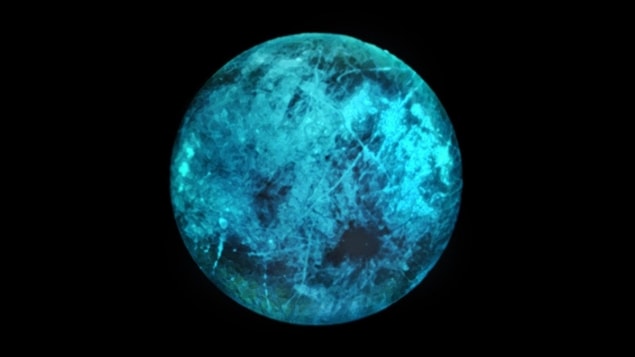
Ice on the night-side surface of Jupiter’s moon Europa could emit a unique glow, according to US-based scientists Murthy Gudipati, Bryana Henderson at NASA’s Jet Propulsion Laboratory and Fred Bateman at the National Institute of Standards and Technology. The researchers did lab-based experiments that suggest that the ice emits visible light as a result of being bombarded by high-energy particles. Their research provides important information for NASA’s upcoming Europa Clipper mission – which could offer an unprecedented glimpse of the composition of Europa’s subsurface ocean.
Europa is Jupiter’s fourth largest moon and as it passes through the strong magnetic field of its host planet, its surface is bombarded by high-energy protons, electrons, and ions. As these particles interact with the moon’s salt- and ice-rich crust, they could trigger complex physical and chemical processes that have important consequences for Europa’s chemical composition.
On geological timescales, the energy-rich products of these reactions could be transported through Europa’s crust, before entering the vast ocean of liquid water beneath. Warmed by tidal forces, this ocean is one of the most promising candidate locations for extraterrestrial life in the solar system. Determining the composition of salt on Europa’s surface should therefore provide important clues about whether life could exist in its ocean.
High-energy electrons
In their study, the trio fired high-energy electrons at water ice containing different types of salt and analysed the light emitted by their samples. They discovered that the samples emitted characteristic light spectra at visible wavelengths. They also found that emission was enhanced in ice containing magnesium-sulphate based epsomite, and that ice containing sodium chloride and sodium carbonate gives off much less light. On Europa’s surface, this light emission would create a unique nighttime glow, not likely to be found elsewhere in the solar system.
By mapping variations in this glow on Europa’s surface, the trio believe that scientists could determine what salts are present within Europa’s ice, and in what concentrations. While dark regions could indicate the presence of sodium- and chloride-rich surfaces, while brighter areas may give away magnesium- and sulphate- dominated surfaces. Comparing these variations with observations of Europa’s daytime side would then enable astronomers to identify specific geological features by their chemical compositions.
Gudipati and colleagues now hope that through future missions, spacecraft flying low over Europa’s night-side surface could observe this light directly. This will soon be soon be possible through visible instruments aboard NASA’s Europa Clipper mission, which due for launch in 2025. These observations could be key to determining whether life could exist beneath Europa’s surface, and may also pave the way for analyses of other Jovian moons subjected to particle bombardment, including Io and Ganymede.
The research is described in Nature Astronomy.



